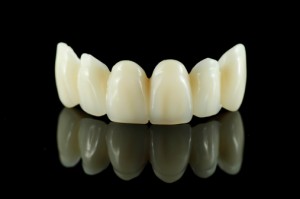Understanding Dental Bridges
Dental bridges are an affordable solution for replacing a few missing teeth.
If you have lost a tooth, the best way to replace it from a health and aesthetics perspective is with a dental implant. However, dental implants can be costly, and depending on your budget and your priorities you may wish to explore less expensive alternatives to replacing missing teeth. For most patients, this means dental bridges.
What Can Dental Bridges Accomplish?
Dental bridges provide the following benefits:
- Restoring the beauty of your smile
- Preventing other teeth from shifting into the gap left by a missing tooth
- Allowing you to bite and chew normally
- Reducing the risk of developing jaw problems due to a misaligned bite
The main drawbacks of a dental bridge compared to a dental implant is that they do not arrest bone loss in the jaw, and they will need replacement sooner.
Who Can Get Dental Bridges?
Patients can consider dental bridges to replace missing teeth if they meet all these requirements:
- Only a small number of teeth are missing
- The teeth on either side of the gap (anchor teeth) are in good condition
- The gum tissue surrounding the anchor teeth is healthy
- Overall oral hygiene is good
Types of Dental Bridges
Depending on the location of the teeth you need to replace, your dentist may recommend:
- Traditional Fixed Bridge: In this type of bridge, two crowns will be placed over the teeth adjacent to the gap (anchor teeth). The replacement tooth or teeth will be bonded to these crowns for support. This is the strongest and most common type of bridge.
- Resin-Bonded Bridge: Another possibility is to support the replacement tooth with metal wings that are resin-bonded onto the anchor teeth. This type of bridge has the advantage of preventing healthy anchor teeth from needing to be covered with crowns. However, it is not as strong as a traditional bridge and is only used to replace front teeth. Patients need to be careful not to put too much bite force on this type of bridge.
- Cantilever Bridge: A cantilever bridge only uses one anchor tooth to support the false tooth.
With any of these types of dental bridges, you will have the choice of having the replacement tooth as well as the crowns for any anchor teeth made from porcelain or metal (typically gold). The most common choice is porcelain, as this provides a very natural look. Porcelain bridges reflect light almost exactly like natural teeth would so your bridgework should not detract from the look of your smile at all.
Why Get Your Bridge at California Dental Group
At California Dental Group, we make every effort to make the process of getting your dental bridges as simple and comfortable as possible. We use an iTero scanner rather than messy dental molds to get the specs for creating your replacement tooth and/or crowns, and we work with an excellent dental lab to make sure these materials get made quickly and correctly. You can rely on our dentists to place your bridges properly and provide you with expert oral care advice so you can get many years of comfortable service out of your restorations.





